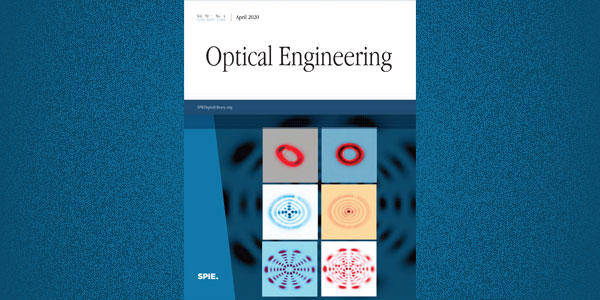Wits students’ research on cover of leading world optics journal
- Wits University
Wits Master’s students create best practice guide for efficient and accurate use of DMDs in structured light laboratories.
A research paper by a group of Master’s students at Wits University features on the cover of the April issue of the prestigious optics journal, Optical Engineering, published by the Society of Photo-Optical Instrumentation Engineers (SPIE) Digital Library, the world’s largest collection of optics and photonics applied research.
Lead author, Stirling Scholes, and co-authors Ravin Kara, Jonathan Pinnell, Valeria Rodríguez-Fajardo, together with Professor Andrew Forbes from the Structured Light Laboratory in the Wits School of Physics worked on the paper, titled: Structured light with digital micromirror devices: a guide to best practice.

“Our paper is one of the most comprehensive guides published to date for the use of digital micromirror devices (DMDs) in structured light research, and is particularly appealing for optics laboratories in Africa given the high costs of buying equipment overseas for this field of study,” says Stirling.
“To be on the cover of Optical Engineering is both prestigious and useful. It means that the paper is more likely to be read, remembered, and shared. This will help both new researchers planning to use DMDs and existing labs who wish to standardise DMD operation. Being featured on the cover of a leading international journal shows the potency of science in Africa and cements the reputation of Wits as the leading physics institution on the continent,” he adds.
Stirling explains that structured light is a field of physics dedicated to understanding and controlling all of the different properties of light, such as polarization, shape and wavelength.
“By manipulating these properties, we can forge light into a powerful tool for advancing not only our understanding of the Universe, but also our quality of life by revolutionising technologies in everything from the smartphone industry to medical imaging.”
“But while new technologies are constantly being developed, a common approach to create structured light is to use what is called a Spatial Light Modulator (SLM),” says Stirling, adding that a SLM is an electronic screen that displays a ‘hologram’, a carefully designed picture so that when the SLM is illuminated, light with a desired set of properties is produced.
Enter DMDs
Recently, a new type of SLM called a Digital Micromirror Device (DMD) has emerged.
DMDs were originally developed for use in digital projectors and are built around a screen made up of millions of microscopic mirrors.
Stirling explains: “These devices have rapidly become widely used thanks to their low cost when compared to other more traditional SLM. However, despite their growing ubiquity there was ambiguity around the proper usage of DMDs in the laboratory environment - this was what our paper set out to tackle.”
Two key factors influence the performance of SLMs:
- Optical efficiency – how much of the illuminated light is wasted by the device, rather than being available for the application, and
- Accuracy – how closely does the light produced match the desired outcome?
“Our research addressed both of these issues. First, we derived a mathematical model to predict the optical efficiency of the DMD based on how it was illuminated. We then validated our model using measurements taken in the lab. We found that the optimal configuration for illumination yields a 20% improvement in efficiency.
“However, this improvement would not be beneficial if it came at the expense of accuracy. We iteratively adjusted the picture the DMD displayed until we achieved the best possible accuracy, in excess of 96%.”
“Finally, we described some of the subtler aspects of DMD operation to a na?ve user. Our paper is one of the most comprehensive guides to DMD use published to date,” says Stirling.

